中级财务会计第十章财务会计报告习题
- 格式:docx
- 大小:26.20 KB
- 文档页数:7
![[经济学]中级财务会计 第10章所有者权益](https://uimg.taocdn.com/84c0c26ce45c3b3567ec8bd0.webp)
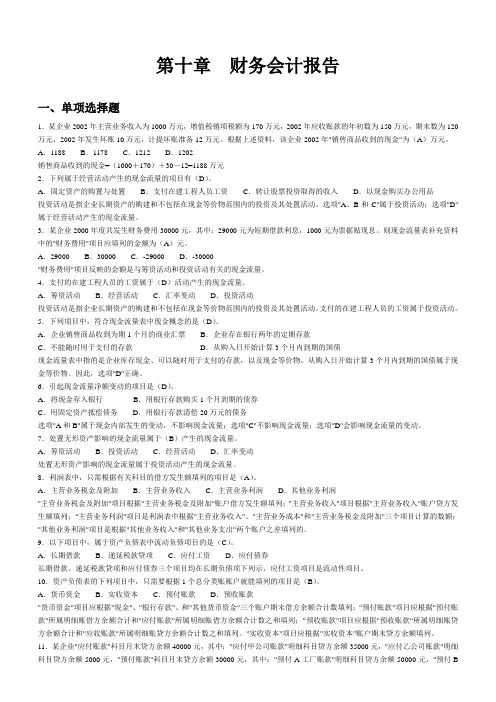
第十章财务会计报告一、单项选择题1.某企业2002年主营业务收入为1000万元,增值税销项税额为170万元,2002年应收账款的年初数为150万元,期末数为120万元,2002年发生坏账10万元,计提坏账准备12万元。
根据上述资料,该企业2002年"销售商品收到的现金"为(A)万元。
A.1188B.1178C.1212D.1202销售商品收到的现金=(1000+170)+30-12=1188万元2.下列属于经营活动产生的现金流量的项目有(D)。
A.固定资产的购置与处置B.支付在建工程人员工资C.转让股票投资取得的收入D.以现金购买办公用品投资活动是指企业长期资产的购建和不包括在现金等价物范围内的投资及其处置活动。
选项"A、B和C"属于投资活动;选项"D"属于经营活动产生的现金流量。
3.某企业2000年度共发生财务费用30000元,其中:29000元为短期借款利息,1000元为票据贴现息。
则现金流量表补充资料中的"财务费用"项目应填列的金额为(A)元。
A.29000B.30000C.-29000D.-30000"财务费用"项目反映的金额是与筹资活动和投资活动有关的现金流量。
4.支付的在建工程人员的工资属于(D)活动产生的现金流量。
A.筹资活动B.经营活动C.汇率变动D.投资活动投资活动是指企业长期资产的购建和不包括在现金等价物范围内的投资及其处置活动。
支付的在建工程人员的工资属于投资活动。
5.下列项目中,符合现金流量表中现金概念的是(D)。
A.企业销售商品收到为期1个月的商业汇票B.企业存在银行两年的定期存款C.不能随时用于支付的存款D.从购入日开始计算3个月内到期的国债现金流量表中指的是企业库存现金、可以随时用于支付的存款,以及现金等价物。
从购入日开始计算3个月内到期的国债属于现金等价物。
因此,选项"D"正确。
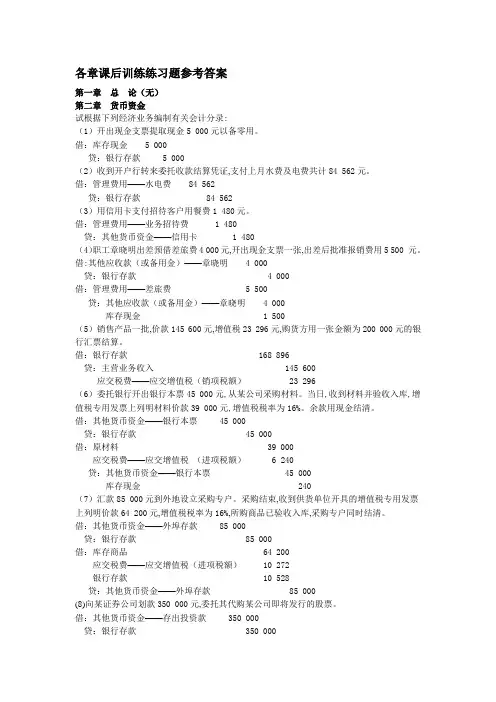
各章课后训练练习题参考答案第一章总论(无)第二章货币资金试根据下列经济业务编制有关会计分录:(1)开出现金支票提取现金5 000元以备零用。
借:库存现金 5 000贷:银行存款 5 000(2)收到开户行转来委托收款结算凭证,支付上月水费及电费共计84 562元。
借:管理费用——水电费 84 562贷:银行存款 84 562(3)用信用卡支付招待客户用餐费1 480元。
借:管理费用——业务招待费 1 480贷:其他货币资金——信用卡 1 480(4)职工章晓明出差预借差旅费4 000元,开出现金支票一张,出差后批准报销费用5 500 元。
借:其他应收款(或备用金)——章晓明 4 000贷:银行存款 4 000借:管理费用——差旅费 5 500贷:其他应收款(或备用金)——章晓明 4 000库存现金 1 500(5)销售产品一批,价款145 600元,增值税23 296元,购货方用一张金额为200 000元的银行汇票结算。
借:银行存款 168 896 贷:主营业务收入 145 600应交税费——应交增值税(销项税额) 23 296(6)委托银行开出银行本票45 000元,从某公司采购材料。
当日,收到材料并验收入库,增值税专用发票上列明材料价款39 000元,增值税税率为16%。
余款用现金结清。
借:其他货币资金——银行本票 45 000贷:银行存款 45 000借:原材料 39 000应交税费——应交增值税(进项税额) 6 240贷:其他货币资金——银行本票 45 000库存现金 240 (7)汇款85 000元到外地设立采购专户。
采购结束,收到供货单位开具的增值税专用发票上列明价款64 200元,增值税税率为16%,所购商品已验收入库,采购专户同时结清。
借:其他货币资金——外埠存款 85 000贷:银行存款 85 000借:库存商品 64 200应交税费——应交增值税(进项税额) 10 272银行存款 10 528贷:其他货币资金——外埠存款 85 000(8)向某证券公司划款350 000元,委托其代购某公司即将发行的股票。
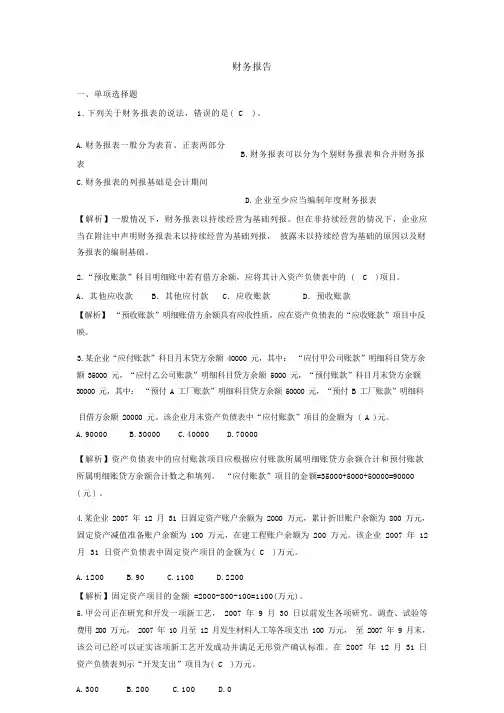
财务报告一、单项选择题1.下列关于财务报表的说法,错误的是( C )。
A.财务报表一般分为表首、正表两部分B.财务报表可以分为个别财务报表和合并财务报表C.财务报表的列报基础是会计期间D.企业至少应当编制年度财务报表【解析】一般情况下,财务报表以持续经营为基础列报。
但在非持续经营的情况下,企业应当在附注中声明财务报表未以持续经营为基础列报,披露未以持续经营为基础的原因以及财务报表的编制基础。
2.“预收账款”科目明细账中若有借方余额,应将其计入资产负债表中的 ( C )项目。
A.其他应收款 B.其他应付款 C.应收账款 D.预收账款【解析】“预收账款”明细账借方余额具有应收性质,应在资产负债表的“应收账款”项目中反映。
3.某企业“应付账款”科目月末贷方余额 40000 元,其中:“应付甲公司账款”明细科目贷方余额 35000 元,“应付乙公司账款”明细科目贷方余额 5000 元,“预付账款”科目月末贷方余额30000 元,其中:“预付 A 工厂账款”明细科目贷方余额 50000 元,“预付 B 工厂账款”明细科目借方余额 20000 元。
该企业月末资产负债表中“应付账款”项目的金额为 ( A )元。
A.90000B.30000C.40000D.70000【解析】资产负债表中的应付账款项目应根据应付账款所属明细账贷方余额合计和预付账款所属明细账贷方余额合计数之和填列。
“应付账款”项目的金额=35000+5000+50000=90000 (元)。
4.某企业 2007 年 12 月 31 日固定资产账户余额为 2000 万元,累计折旧账户余额为 800 万元,固定资产减值准备账户余额为 100 万元,在建工程账户余额为 200 万元。
该企业 2007 年 12 月 31 日资产负债表中固定资产项目的金额为( C )万元。
A.1200B.90C.1100D.2200【解析】固定资产项目的金额 =2000-800-100=1100(万元)。

第一章绪论一、概念题:1、财务会计:以传统会计为主要内容,以提供企业外部利益主体所需的经济信息为主要任务,使用的重要会计手段是复试记账、编制与审核凭证、登记账簿,编报财务会计报告等。
在财务会计中,会计凭证上反映的经济业务是已经发生的会计事项,记账凭证上反映的应该是根据公认会计原则确认和计量的结果,财务会计报表反映的是账实相符的、外部利益主体关心的、以财务信息为主的经济信息,并且这些经济信息必须以规定的格式、相同口径的经济指标反映。
2、管理会计:是适应现代企业管理需要,突破传统会计而发展起来的,以财务会计资料为基本依托、相对独立的会计学科。
其服务对象是企业内部各级管理人员,不需要固定的程序,既不受任何统一的会计制度等法规的约束,也不受固定的程序和会计惯例的制约。
规范与控制是管理会计的两大内容。
3、确认:是指通过一定的标准,辨认应输入会计信息系统的经济数据,确定这些数据应加以记录的会计对象的要素,进而缺点已记录和加工的信息是否应全部列入财务会计报表和如何列入财务会计报表的过程。
4、计量:是指在企业会计核算中对会计对象的内在数量关系加以衡量、计算和确定,使其转化为能用货币表现的财务信息和其他有关的经济信息,以便集中和综合反映企业经营成果、财务状况及其变动情况。
计量的主要尺度是货币,结果主要是财务信息。
5、会计假设:是关于会计核算中的程序与方法适用的基本条件的约定,主要包括会计主体、持续经营、会计分期和货币计量。
6、会计目标:财务会计工作应达到的境地。
我国财务会计的基本目标是向财务会计报告的使用者提供与企业财务状况、经营成果和现金流量等有关的会计信息,反映企业管理层受托责任履行情况,有助于财务会计报告使用者作出经济决策。
二、简答题:1、如何理解会计的目标?答:(1)财务会计的目标是指财务会计工作应达到的境地。
在多数情况下,人们基本上把财务会计的目标与财务会计报表的目标等同起来。
(2)我国财务会计的基本目标是向财务会计报告的使用者提供与企业财务状况、经营成果和现金流量等有关的会计信息,反映企业管理层受托责任履行情况,有助于财务会计报告使用者作出经济决策。
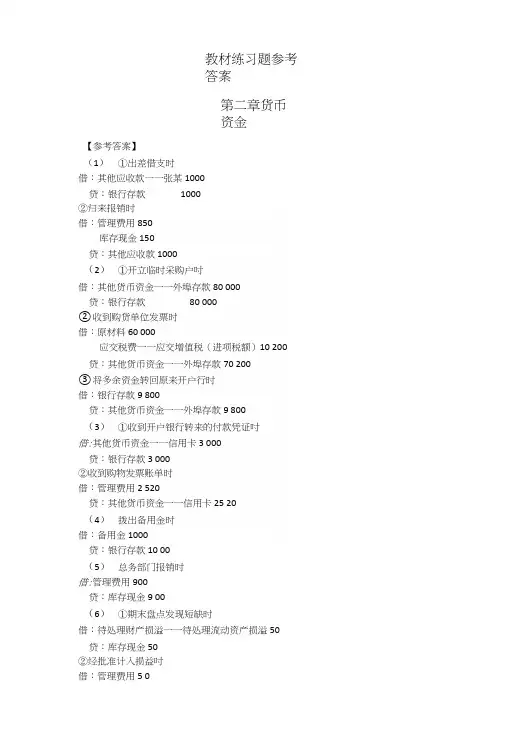
教材练习题参考答案第二章货币资金【参考答案】(1)①出差借支时借:其他应收款一一张某1000贷:银行存款1000②归来报销时借:管理费用850库存现金150贷:其他应收款1000(2)①开立临时采购户吋借:其他货币资金一一外埠存款80 000贷:银行存款80 000②收到购货单位发票时借:原材料60 000应交税费一一应交增值税(进项税额)10 200贷:其他货币资金一一外埠存款70 200③将多余资金转回原来开户行时借:银行存款9 800贷:其他货币资金一一外埠存款9 800(3)①收到开户银行转来的付款凭证吋借:其他货币资金一一信用卡3 000贷:银行存款3 000②收到购物发票账单时借:管理费用2 520贷:其他货币资金一一信用卡25 20(4)拨出备用金时借:备用金1000贷:银行存款10 00(5)总务部门报销时借:管理费用900贷:库存现金9 00(6)①期末盘点发现短缺时借:待处理财产损溢一一待处理流动资产损溢50贷:库存现金50②经批准计入损益吋借:管理费用5 0贷:待处理财产损溢一一待处理流动资产损溢50第三章应收款项【参考答案】1.(1)办妥托收银行收款手续时:借:应收账款11700贷:主营业务收入10 000应交税费一应交增值税(销项税额)17 0 00(2)如在10天内收到货款时借:银行存款11 466财务费用23 4贷:应收账款11700(3)如在30内收到货款时借:银行存款11700贷:应收账款117002.(1)收到票据时借:应收票据93 6 00贷:主营业务收入80 000应交税费一应交增值税(销项税额)13 600(2)年终计提票据利息借:应收票据15 60贷:财务费用1560(3 )到期收回货款借:银行存款98 280贷:应收票据95 160财务费用3 1203.(1)第一年末借:资产减值损失5 000贷:坏账准备5 000(2)第二年末借:资产减值损失7 500贷:坏账准备7 500(3 )第三年末借:坏账進备1500贷:资产减值损失1500(3)第四年6月发生坏账时借:坏账准备18 000贷:应收账款18 00010月收回己核销的坏账时借:应收账款5 00 0贷:坏账准备5 000借:银行存款5 000贷:应收账款5000年末计提坏账准备时借:资产减值损失1 2 000贷:坏账准备12 00 0第四章存货【参考答案】1.(1)实际成本核算:该批甲材料的实际总成本=20 000+200=2 0 200 (元)借:原材料•甲材料20 2 00应交税费•应交增值税3 400贷:银行存款23 600(2)计划成本核算①购进借:材料采购■甲材料20 200应交税费•应交增值税3 400贷:银行存款23 600②入库材料成本差异=20 200-990X18 =2380元,超支差异借:原材料--- 甲材料17 820 (=990X18)材料成本差异2380贷:材料采购——甲材料20 20 02.(1)先进先出法6月7日①发出A材料的成本=200X 60+20 0X 66=25 20 0 (元)6月18日②发出A材料的成本=300X 66 +500X 70=54 800 (元)6月29日③发出A材料的成本=100 X70+200X68 =20 600 (元)期末结存A材料成本=300X68=20 400 (元)(2)月末一次加权平均法加权平均单位成本二(12 000+109 0 00) 4- (200+1 600) ^67.22 (元/公斤)期末结存A材料的成本=300 X67.22=201 66 (元)本月发出A 材料的成本二(12 000+109 00 0) -20166=1 00834 (元)(3 )移动加权平均法6月5日①购进后移动平均单位成本二(12000+33 000)一(200+500) =64.29 (元/公斤)6月7日结存A材料成本=300X64 .29=19287 (元)6 月7 日发出A 材料成本=(12000+330 00) -19287=25713 (元)6月16日②购进后移动平均单位成本二(19287+42 000) 4- (300+600) =68.10 (元/公斤)6月18日结存A材料成本=100X68 .10=6810 (元)6 月18 日发出A 材料成本二(19287+4200 0) -6810=54 477 (元)6月27日③购进后移动平均单位成本二(6810+34000 )0 (100+500 )=68.02 (元/公斤)6月29日结存A材料成本=300X68.02 =20406 (元)6月29日发出A材料成本二(68 10+34000)・20406=2040 4 (元)期末结存A材料成本=300X68 .02=20406 (元)3.A产品:有销售合同部分:A产品可变现净值=40X (1105)=4 20(万元),成本=40X10=400 (万元),这部分存货不需计提跌价准备。
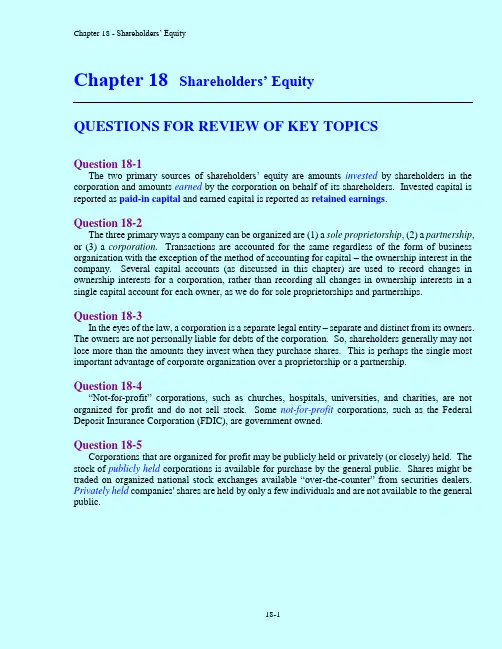
Chapter 18Shareholders’ EquityQUESTIONS FOR REVIEW OF KEY TOPICSQuestion 18-1The two primary sources of shareholders’ equity are amounts invested by shareholders in the corporation and amounts earned by the corporation on behalf of its shareholders. Invested capital is reported as paid-in capital and earned capital is reported as retained earnings.Question 18-2The three primary ways a company can be organized are (1) a sole proprietorship, (2) a partnership, or (3) a corporation. Transactions are accounted for the same regardless of the form of business organization with the exception of the method of accounting for capital – the ownership interest in the company. Several capital accounts (as discussed in this chapter) are used to record changes in ownership interests for a corporation, rather than recording all changes in ownership interests in a single capital account for each owner, as we do for sole proprietorships and partnerships. Question 18-3In the eyes of the law, a corporation is a separate legal entity – separate and distinct from its owners. The owners are not personally liable for debts of the corporation. So, shareholders generally may not lose more than the amounts they invest when they purchase shares. This is perhaps the single most important advantage of corporate organization over a proprietorship or a partnership.Question 18-4―Not-for-profit‖ corporations, such as churches, hospitals, universities, and charities, are not organized for profit and do not sell stock. Some not-for-profit corporations, such as the Federal Deposit Insurance Corporation (FDIC), are government owned.Question 18-5Corporations that are organized for profit may be publicly held or privately (or closely) held. The stock of publicly held corporations is available for purchase by the general public. Shares might be traded on organized national stock exchanges available ―over-the-counter‖ from securities dealers. Privately held companies' shares are held by only a few individuals and are not available to the general public.Question 18-6Corporations are formed in accordance with the corporation laws of individual states. The Model Business Corporation Act serves as the guide to states in the development of their corporation statutes, presently as the model for the majority of states.Answers to Questions (continued)Question 18-7The ownership rights held by common shareholders, unless specifically withheld by agreement with the shareholders, are:a. The right to vote on policy issues.b. The right to share in profits when dividends are declared (in proportion to the percentage ofshares owned by the shareholder).c. The right to share in the distribution of any assets remaining at liquidation after other claims aresatisfied.Question 18-8The ―preemptive right‖ is the right to maintain one’s percentage share of ownership when new shares are issued. When granted, each shareholder is offered the opportunity to buy the same percentage of any new shares issued as the percentage of shares he/she owns at the time. For reasons of practicality, the preemptive right usually is excluded.Question 18-9The typical rights of preferred shares usually include one or both of the following:a. A preference to a predesignated amount of dividends, i.e., a stated dollar amount per share or %of par value per share. This means that when the board of directors of a corporation declares dividends, preferred shareholders will receive the specified dividend prior to any dividends being paid to common shareholders.b. A preference over common shareholders in the distribution of assets in the event the corporationis dissolved.Question 18-10If preferred shares are noncumulative, dividends not declared in any given year need never be paid. However, if cumulative, when the specified dividend is not paid in a given year, the unpaid dividends accumulate and must be made up in a later dividend year before any dividends are paid on common shares. These unpaid dividends are called ―dividends in arrears.‖Question 18-11Par value was defined by early corporation laws as the amount of net assets not available for distribution to shareholders (as dividends or otherwise). However, now the concepts of ―par value‖ and ―legal capital‖ have been eliminated entirely from the Mod el Business Corporation Act. Most shares continue to bear arbitrarily designated par values, typically nominal amounts. Although many states already have adopted these provisions, most established corporations issued shares prior to changes in the state statutes. So, most companies still have par value shares outstanding and continue to issue previously authorized par value shares.Answers to Questions (continued)Question 18-12Comprehensive income is a broader view of the change in shareholders’ equ ity than traditional net income. It is the total nonowner change in equity for a reporting period. It encompasses all changes in equity except those caused by transactions with owners. Transactions between the corporation and its owners (shareholders) primarily include dividends and the sale or purchase of shares of the company’s stock. Most nonowner changes (e. g., revenues and expenses) are reported in the income statement. So, the changes other than the ones that are part of net income are those reported as ―other comprehensive income.‖Two attributes of other comprehensive income are reported: (1) components of comprehensive income created during the reporting period and (2) the comprehensive income accumulated over the current and prior periods.The components of comprehensive income created during the reporting period - can be reported either (a) as an additional section of the income statement, (b) as part of the statement of shareholders’ equity, or (c) in a disclosure note. Regardless of the choice a company makes, the presentation will report net income, other components of comprehensive income, and total comprehensive income. The second attribute - the comprehensive income accumulated over the current and prior periods–is reported as a sep arate component of shareholders’ equity. This amount represents the cumulative sum of the changes in each component created during each reporting period throughout all prior years. Question 18-13As part of a joint project with the FASB, the International Accounting Standards Board (IASB) in 2007 issued a revised version of IAS No.1,―Presentation of Financial Statements,‖ that revised the standard to bring international reporting of comprehensive income largely in line with U.S. standards. It provides the option of presenting revenue and expense items and components of other comprehensive income either in (a) a single statement of comprehensive income or (b) two statements: an income statement and a statement of comprehensive income, traditionally referred to as the Statement of Recognized Income and Expense, or ―SoRIE.‖ U.S. GAAP also allows reporting other comprehensive income in the statement of shareholders’ equity, which is the way most U.S. companies report it.Question 18-14The statement of shareho lders’ equity reports the transactions that cause changes in its shareholders’ equity account balances. It shows the beginning and ending balances in primary shareholders’ equity accounts and any changes that occur during the years reported. Typical reas ons for changes are the sale of additional shares of stock, the acquisition of treasury stock, net income, and the declaration of dividends.Question 18-15The measurement objective is that the transaction should be recorded at fair value. This might be the fair value of the shares or of the noncash assets or services received, whichever evidence of fair value seems more clearly evident. This is consistent with the general practice of recording any noncash transaction at market value.Answers to Questions (continued)Question 18-16The cash received usually is the sum of the separate market values of the separate securities. However, when the total selling price is not equal to the sum of the separate market prices, the total selling price is allocated in proportion to their relative market values.Question 18-17Share issue costs reduce the net cash proceeds from selling the shares and thus paid-in capital –excess of par. On the other hand, debt issue costs are recorded in a separate ―debt issue costs‖ account and amortized to expense over the life of the debt. The difference often is justified by the presumption that share issue costs and debt issue costs are fundamentally different because a debt issue has a fixed maturity, but that selling shares represents a perpetual equity interest. Concept Statement 6 disagrees, stating that debt issue costs should be treated the same way as share issue costs. But, Concept Statements do not constitute GAAP, and the currently prescribed practice is to record debt issue costs as assets and expense the asset over the maturity of the debt.Question 18-18The same accounts that previously were increased when the shares were sold are decreased when the shares are retired. Specifically, common (or preferred) stock and paid-in capital – excess of par are reduced by the same amounts they were increased by when the shares were originally sold.If the cash paid to repurchase the shares differs from the amount originally paid in, accounting for the difference depends on whether the cash paid to repurchase the shares is less than or more than the price previously received when the shares were sold. When less cash is distributed to shareholders to retire shares than originally paid in, some of the original investment remains and is labeled paid-in capital –share repurchase. When more cash is distributed to shareholders to retire shares than originally was paid in for those shares, the additional amount is viewed as a dividend on the original investment, and thus a reduction of retained earnings (unless previous share repurchases have created a balance in paid-in capital – share repurchase which would be reduced first).Question 18-19The purchase of treasury stock and its subsequent resale are considered to be a ―single transaction.‖ The purchase of treasury stock is perceived as a temporary reduction of shareholders' equity, to be reversed later when the treasury stock is resold, so the cost of acquiring the shares is ―temporarily‖ debited to the treasury stock account. Allocating the effects to specific shareholders’ equity accounts is deferred until the shares are subsequently reissued.Answers to Questions (concluded)Question 18-20For a stock dividend of less than 25%, a "small" stock dividend, the fair value of the additional shares distributed is transferred from retained earnings to paid-in capital. The reduction in retained earnings is the same amount as if cash dividends were paid equal to the market value of the shares issued. The treatment is consistent with the belief that per share prices remain unchanged by stock dividends.This is not logical. If the value of each share were to remain the same when additional shares are distributed without compensation, the total value of the company would grow simply because additional stock certificates are distributed. Instead, the market price per share will decline in proportion to the increase in the number of shares distributed in a stock dividend.Question 18-21The effect and maybe the motivation for the stock split is to reduce the per share market price (by half). This will likely increase the stock’s marketability by making it attractive to a larger number of potential investors. The appropriate accounting treatment of a stock split is to make no journal entry, which avoids the reclassification of ―earned‖ capital as ―invested‖ capital. However, if the stock distribution is referred to as a "stock split effected in the form of a stock dividend," and the per share par value of the shares is not changed, a journal entry is recorded that increases the common stock account by the par value of the additional shares. To avoid reducing retained earnings Brandon can reduce (debit) paid-in capital –excess of par to offset the credit to common stock, although it’s permissible to debit retained earnings.Question 18-22When a company decreases, rather than increases, its outstanding shares a reverse stock split occurs. A 1 for 2 reverse stock split would cause one million $1 par shares to become one-half million $2 par shares. No journal entry would be recorded, so no account balances will change. But the market price per share would double, and the par amount per share would double.Question 18-23You would be entitled to 3.2 shares (4% x 80 shares). Since cash in lieu of payments usually are made when shareholders are entitled to fractions of whole shares, you probably would receive 3 shares and cash equal to the market value of 1/5 of one share. Sometimes fractional share rights are issued for the partial shares, which would entitle you to a fractional share right for 1/5of a share.Question 18-24A quasi reorganization allows a company to (1) write down inflated asset values and (2) eliminate an accumulated deficit in retained earnings. The following steps are taken:1. Assets and liabilities are revalued to reflect their fair values, with corresponding credits or debitsto retained earnings. This may temporarily increase the deficit.2. The debit balance in retained earnings is eliminated against additional paid-in capital. Whenadditional paid-in capital is not sufficient to absorb the entire deficit,capital stock is debited.3. Disclosure is provided to indicate the date the deficit was eliminated and when the newaccumulation of earnings began.BRIEF EXERCISESBrief Exercise 18-1Two attributes of other comprehensive income are reported: (1) components of comprehensive income created during the reporting period($15 million in this instance) and (2) the comprehensive income accumulated over the current and prior periods ($50 million at the end of this year).The $50 million represents the cumulative sum of the changes in each component created during each reporting period (the disclosure note) throughout all prior years. Since this amount increased by $15 million, the balance must have been $35 million last year.Brief Exercise 18-2($ in millions) Cash (8 million shares x $12 per share) (96)Common stock (8 million shares x $1 par per share) (8)Paid-in capital – excess of par (remainder) (88)Lewelling’s paid-in capital – excess of par will increase by $860,000: 4,000 hours x $240 less $100,000 par.Journal entry (not required):Legal expense (4,000 hours x $240) .................................... 960,000Common stock (100,000 shares x $1 par per share)............... 100,000Paid-in capital – excess of par (remainder) ................... 860,000Brief Exercise 18-4Hamilton’s shareholders’ equity will increase by $3,500,000 as a result of this transaction.Journal entry (not required):Inventory of motors (1,000 x $3,500)................................. 3,500,000Common stock ............................................................. 3,500,000MLS’s common shareholders’ will receive dividends of $18 million as a result of the 2011 distribution.Preferred Common2009 $20 million*02010 20 million**02011 32 million***$18 million(remainder)* $24 million current preference (6% x $400 million), thus $4 million dividends in arrears.**$24 million current preference (6% x $400 million), thus another $4 million dividends in arrears.*** $8 million dividends in arrears plus the $24 million current preference.Brief Exercise 18-6Horton’s total paid-in capital will decline by $17 million, the price paid to buy back the shares.Journal entry (not required):($ in millions) Common stock (2 million shares x $1 par) (2)Paid-in capital – excess of par (2 million shares x $9*) (18)Paid-in capital – share repurchase (difference) (3)Cash (2 million shares x $8.50 per share) (17)* Paid-in capital – excess of par: $900 ÷ 100 million sharesBrief Exercise 18-7Agee’s total paid-in capital will decline by $18 million because recording thetransaction involves a $1 million reduction of retained earnings and an $18 million reduction in paid-in capital accounts.Journal entries (not required):First buyback ($ in millions)Common stock (1 million shares x $1 par) (1)Paid-in capital – excess of par (1 million shares x $15*) (15)Paid-in capital – share repurchase (difference) (2)Cash (1 million shares x $14) (14)* $16 - $1 parSecond buybackCommon stock (1 million shares x $1 par) (1)Paid-in capital – excess of par (1 million shares x $15*) (15)Paid-in capital – share repurchase (balance from first buyback).. 2Retained earnings (difference) (1)Cash (1 million shares x $19) (19)* $16 - $1 parBrief Exercise 18-8Jennings’ retained earnings will decline by $2 million because the $67 million sale price is less than the sum of the cost of the treasury stock ($70 million) and paid-in capital from the previous treasury stock sale ($1 million).Journal entries (not required):Purchase of treasury stock ($ in millions)Treasury stock (2 million shares x $70) (140)Cash (140)First sale of treasury stockCash (1 million shares x $71) (71)Treasury stock (1 million shares x $70) (70)Paid-in capital – share repurchase (remainder) (1)Second sale of treasury stockCash (1 million shares x $67) (67)Paid-in capital – share repurchase (balance from first sale) (1)Retained earnings (remainder) (2)Treasury stock (1 million shares x $70) (70)Brief Exercise 18-9Cox’ paid-in capital – share repurchase will increase by $7 million as determined in the following journal entry:($ in millions) Cash (1 million shares x $29) (29)Paid-in capital – share repurchase (difference) (7)Treasury stock (1 million shares x $22*) (22)* 2 million shares x $20 = $40 million1 million shares x $26 = 26 million3 million shares $66 million$66 million ÷ 3 million shares = $22 average cost per shareBrief Exercise 18-10Cox’ paid-in capital – share repurchase will increase by $9 million as determined in the following journal entry:($ in millions) Cash (1 million shares x $29) (29)Paid-in capital – share repurchase (difference) (9)Treasury stock (1 million shares x $20*) (20)* 2 million shares x $20 = $40 million (first million at $20)1 million shares x $26 = 26 million$66 millionBrief Exercise 18-11Declaration date ($ in millions) Retained earnings .............................................................. 1,158Cash dividends payable (8,908 million shares x $.13)....... 1,158 Date of recordno entryPayment dateCash dividends payable .................................................... 1,158Cash .............................................................................. 1,158Brief Exercise 18-12Declaration dateLoss on investment ($37,000 - 35,000)................................ 2,000Investment in GE stock ................................................ 2,000Retained earnings (1,000 shares at $35 per share) ......................35,000Property dividends payable .......................................... 35,000 Payment dateProperty dividends payable .............................................. 35,000Investment in GE stock ................................................ 35,000Brief Exercise 18-13($ in millions) Retained earnings (3 million* shares at $25 per share) (75)Common stock (3 million* shares at $1 par per share) (3)Paid-in capital – excess of par (remainder) (72)* 5% x 60 million shares = 3 million sharesBrief Exercise 18-14If a stock split is not to be effected in the form of a stock dividend, no entry isrecorded. Since the shares double, but the balance in the common stock account is not changed, the par per share is reduced, to $.50 in this instance.Brief Exercise 18-15($ in millions) Paid-in capital – excess of par 60Common stock (60 million shares* x $1 par per share)60* 100% x 60 million shares = 60 million sharesIf the per share par value of the shares is not to be changed, the stock distribution is referred to as a "stock split effected in the form of a stock dividend." In that case, the journal entry increases the common stock account by the par value of the additional shares. This prevents the increase in shares from reducing (by half in this case) the par per share. The par is $1 before and after the split.Brief Exercise 18-16If Nestle used U.S. GAAP:∙Ordinary share capital would be Common stock,∙Share premium would be Paid-in capital–excess of par, and∙Translation reserve would be Net gains (losses) from foreign currency translation–AOCI.EXERCISESExercise 18-1Requirement 1Comprehensive income is a mor e expansive view of the change in shareholders’ equity than traditional net income. It is the total nonowner change in equity for a reporting period. In fact, it encompasses all changes in equity other than from transactions with owners. Transactions between the corporation and its shareholders primarily include dividends and the sale or purchase of shares of the company’s stock. Most nonowner changes are reported in the income statement. So, the changes other than those that are part of net income are the ones reported as ―other comprehensive income.‖Requirement 2Two attributes of other comprehensive income are reported: (1) components of comprehensive income created during the reporting period and (2) the comprehensive income accumulated over the current and prior periods.The second measure - the comprehensive income accumulated over the current and prior periods–is reported in the balance sheet as a separate component of shareholders’ equity. This is what Kaufman reported in its balance shee t ($107 million in 2011). Be sure to realize this amount represents the cumulative sum of the changes in each component created during each reporting period (the disclosure note) throughout all prior years.Exercise 18-1 (continued)Requirement 3Kaufman's 2011 balance sheet amount ($107 million) differs from the 2011 amount reported in the disclosure note. On the other hand, the comprehensive income created during the reporting period can be reported either (a) as an additional section of the income s tatement, (b) as part of the statement of shareholders’ equity, or (c) in a disclosure note. This is the measure of comprehensive income Kaufman reported in the disclosure note. Regardless of the placement a company chooses, the presentation is similar. It will report net income, other components of comprehensive income, and total comprehensive income, similar to the following:($ in millions) Net income $xxx Other comprehensive income:Net unrealized holding gains (losses) on investments (net of t ax)†$ xGains (losses) from and amendments to postretirement plans (net of tax)‡(x)Deferred gains (losses) from derivatives (net of tax)§ xGains (losses) from foreign currency translation (net of tax)* x xx Comprehensive income $xxx†Changes in the fair value of securities available-for-sale. (An unrealized loss also might occur from recording an ―other than temporary‖ impairment of an investment in debt securities. As described in Chapter 12, if the fair value of a debt security investment falls below its amortized cost, and that decline if viewed as other than temporary, the current period credit loss is included in net income, but any amount that exceeds the current period credit loss is recorded as a loss in OCI.)‡Gains and losses due to revising assumptions or market returns differing from expectations and prior service cost from amending the plan (described in Chapter 17).§When a derivative designated as a cash flow hedge is adjusted to fair value, the gain or loss is deferred as a component of comprehensive income and included in earnings later, at the same time as earnings are affected by the hedged transaction (described in the Derivatives Appendix to the text).* Gains or losses from changes in foreign currency exchange rates from the translation of foreign subsidiary financial statements. The amount could be an addition to or reduction inshareholders’ equity. (This item is discussed elsewhere in your accounting curriculum.)Notice that each component is reported net of its related income tax expense or income tax benefit.Exercise 18-1 (concluded)Requirement 4From the information Kaufman's financial statements provide, we can determine how the company calculated the $107 million accumulated other comprehensive income in 2011:($ in millions) Accumulated other comprehensive income, 2010 $75Change in net unrealized gains on investments 34 Change in ―other‖ (2) Accumulated other comprehensive income, 2011 $ 107Exercise 18-2Requirement 1The specific citation that describes the guidelines for presenting accumulated other comprehensive income on the statement of shareholders’ equity is FASB ACS220–10–45–14: ―Comprehensive Income–Overall–Other Presentation Matters–Reporting Other Comprehensive Income in the Equity Section of a Statement of Financial Position.”Requirement 245-14 The total of other comprehensive income for a period shall be transferred to a component of equity that is displayed separately from retained earnings and additional paid-in capital in a statement of financial position at the end of an accounting period. A descriptive title such as accumulated other comprehensive income shall be used for that component of equity. An entity shall disclose accumulated balances for each classification in that separate component of equity on the face of a statement of financial position, in a statement of changes in equity, or in notes to the financial statements. The classifications shall correspond to classifications used elsewhere in the same set of financial statements for components of other comprehensive income.Exercise 18-3Indicate by letter whether each of the items listed below most likely is reported in the income statement as Net Income (NI) or in the statement of comprehensive income as Other Comprehensive Income (OCI).ItemsOCI 1. Increase in the fair value of securities available-for-saleNI 2. Gain on sale of landOCI 3. Loss on pension plan assets (actual return less than expected)OCI 4. Gain from foreign currency translationNI 5. Increase in the fair value of trading securitiesOCI 6. Loss from revising an assumption related to a pension planNI 7. Loss on sale of patentOCI 8. Prior service costNI 9. Increase in the fair value of bonds outstanding; fair value optionOCI 10. Gain on postretirement plan assets (actual return more than expected)Exercise 18-4Cash (3 million shares x $17.15 per share).............................. 51,450,000Common stock (3 million shares x $.01 par per share) ....... 30,000Paid-in capital – excess of par (remainder) ................... 51,420,000Exercise 18-5February 12Cash (2 million shares x $9 per share)................................ 18,000,000Common stock (2 million shares x $1 par) ................... 2,000,000 Paid-in capital – excess of par (difference) ................... 16,000,000February 13Legal expenses (40,000 shares x $9 per share).................. 360,000Common stock (40,000 shares x $1 par) ...................... 40,000 Paid-in capital – excess of par (difference) ...................320,000Note: Because 2 million shares sold the previous day for $9 per share, it’s reasonable to assume a $9 per share fair value.February 13Cash ............................................................................. 945,000Common stock (80,000 shares x $1 par) ..................... 80,000 Paid-in capital – excess of par, common*............... 640,000 Preferred stock (4,000 shares x $50 par) ...................... 200,000 Paid-in capital – excess of par, preferred**............ 25,000 * 80,000 shares x [$9 market value - $1 par]** Since the value of the common shares is known ($720,000), the market value of the preferred ($225,000) is assumed from the total selling price ($945,000).November 15Property, plant, and equipment (cash value).................. 3,688,000Common stock (380,000 shares at $1 par per share)...... 380,000 Paid-in capital – excess of par (difference) ............... 3,308,000。

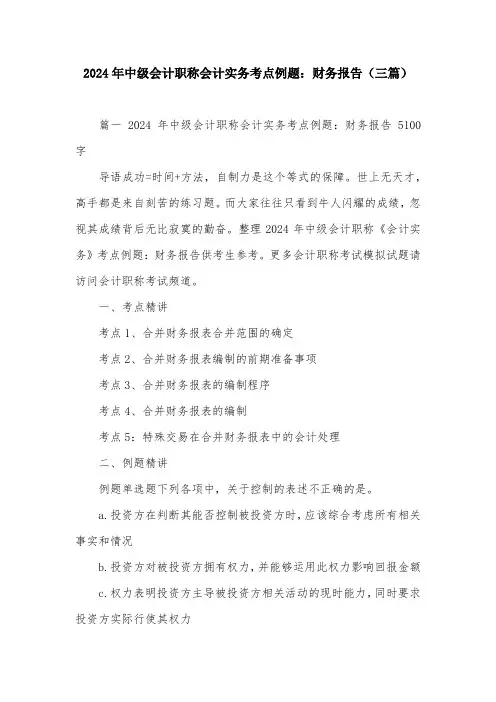
2024年中级会计职称会计实务考点例题:财务报告(三篇)篇一 2024年中级会计职称会计实务考点例题:财务报告5100字导语成功=时间+方法,自制力是这个等式的保障。
世上无天才,高手都是来自刻苦的练习题。
而大家往往只看到牛人闪耀的成绩,忽视其成绩背后无比寂寞的勤奋。
整理2024年中级会计职称《会计实务》考点例题:财务报告供考生参考。
更多会计职称考试模拟试题请访问会计职称考试频道。
一、考点精讲考点1、合并财务报表合并范围的确定考点2、合并财务报表编制的前期准备事项考点3、合并财务报表的编制程序考点4、合并财务报表的编制考点5:特殊交易在合并财务报表中的会计处理二、例题精讲例题单选题下列各项中,关于控制的表述不正确的是。
a.投资方在判断其能否控制被投资方时,应该综合考虑所有相关事实和情况b.投资方对被投资方拥有权力,并能够运用此权力影响回报金额c.权力表明投资方主导被投资方相关活动的现时能力,同时要求投资方实际行使其权力d.权力是一种实质性权利,而不是保护性权利答案c解析选项c,权力只表明投资方主导被投资方相关活动的现时能力,并不要求投资方实际行使其权力。
例题单选题根据相关规定,母公司对能够控制的子公司纳入合并范围,下列各项中,不应纳入母公司合并范围的是。
a.转移资金能力受限的子公司b.业务与母公司有显著差别的子公司c.已被宣告清理整顿的子公司d.与母公司及其他子公司的规模有显著差别子公司答案c解析选项c,已宣告被清理整顿的或已宣告破产的原子公司不再是母公司的子公司,不应纳入合并报表范围。
例题单选题长江公司2024年1月1日自非关联方处购入a公司70%有表决权股份,当日能够对a公司实施控制,长江公司支付购买价款8000万元,另支付审计、评估费50万元。
当日a公司可辨认净资产的账面价值为8000万元,公允价值为9000万元(差额源自一批存货的公允价值高于账面价值1000万元,其他资产和负债的账面价值与计税基础相同)。
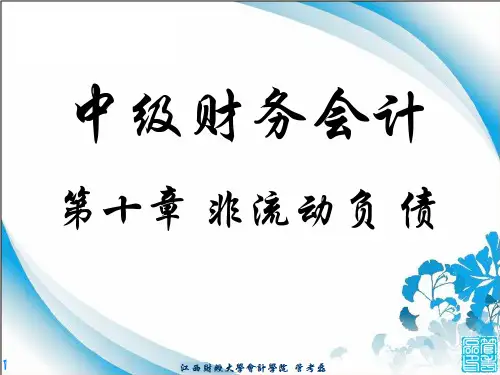

第十章负债一、单项选择题1.下列属于流动负债的是 ( )。
A.短期借款 B.长期借款C.长期应付款 D.应付债券2.“长期借款"科目用来核算( ).A.短期借款的本金和利息的增减情况B.长期借款本金的借入与归还情况C.既不核算本金也不核算利息D.应付债券利息的确认3.企业在无形资产研究阶段发生的职工薪酬应当( )。
A.计入到无形资产成本B.计入到在建工程成本C.计入到长期待摊费用D.计入到当期损益4.逐期计提的长期借款利息应计入( )账户的贷方。
A.应付利息 B.财务费用C.长期借款 D.待摊费用5.企业为购建固定资产而借入的长期借款利息应( )。
A.计入“在建工程"科目B.计入“财务费用”科目C.在固定资产交付使用或办理竣工决算之前计入“在建工程”,之后计入“财务费用"D.在固定资产交付使用或办理竣工决算之前计入“财务费用",之后计入“在建工程”6.某股份有限公司于2007年1月1日溢价发行4年期,到期一次还本付息的公司债券,债券面值为100万元,票面年利率为10%,发行价格为90万元。
债券溢价采用实际利率法摊销,假定实际利率是7。
5%。
该债券2007年度发生的利息费用为( )万元。
A。
6。
5 B。
10C.6。
75D.7.57.应付债券折价发行的原因是().A.票面利率高于市场利率 B.票面利率低于市场利率C.发行公司的财务状况不好 D.发行公司的偿债能力差8。
下列税金中,与企业计算损益无关的是().A.消费税B.一般纳税企业的增值税C.所得税D.城市建设维护税9.企业如果发生无法支付的应付账款时,应计入()。
A.营业外收入B.管理费用C.营业外支出D.资本公积10。
甲企业为一般纳税企业,采用托收承付结算方式从其他企业购入原材料一批,货款为100000元,增值税为17000元,对方代垫的运杂费2000元,该原材料已经验收入库。
该购买业务所发生的应付账款入账价值为( )元。
期末复习专用:中级财务会计题目(含答案)第一章:财务会计基本概念题目1:请简述财务会计的主要目标。
{content}答案1:财务会计的主要目标包括:提供可靠的财务信息,帮助外部利益相关者做出经济决策;反映企业管理层的受托责任履行情况;为外部利益相关者提供企业经营状况和财务状况的信息;帮助外部利益相关者评估企业未来现金流量的金额、时间和不确定性。
---第二章:会计要素与会计等式题目2:请解释会计等式:资产 = 负债 + 所有者权益。
{content}答案2:会计等式是会计核算的基础,表明了企业在任一时点资产的来源,即资产是由企业的负债和所有者权益共同支持的。
资产代表企业拥有或控制的资源,负债代表企业对外的债务,所有者权益则是企业资产扣除负债后由所有者享有的剩余权益。
---第三章:账户式记账法题目3:账户式记账法是如何反映会计要素增减变动的?{content}答案3:账户式记账法通过设置各类会计科目,以借方和贷方为记账方向,记录会计要素的增减变动。
每一笔交易或事项都至少涉及两个会计科目,分别记录在借方和贷方,保持会计等式的平衡。
借方通常记录资产的增加或负债、所有者权益的减少,贷方则相反。
---第四章:货币资金与应收款项题目4:货币资金在财务会计中是如何分类的?{content}答案4:货币资金在财务会计中通常分为三类:库存现金,是企业持有的现金;银行存款,是企业在银行开设的存款账户中持有的资金;其他货币资金,包括企业持有的外币现金、银行存款以及现金等价物等。
---第五章:存货题目5:存货的计价方法有哪些?请举例说明。
{content}答案5:存货的计价方法主要包括先进先出法(FIFO)、后进先出法(LIFO)、加权平均成本法和个别计价法。
- 先进先出法(FIFO):假定最先进入库存的存货最先被耗用或销售,期末存货中剩余的是最后进入库存的存货。
- 后进先出法(LIFO):与FIFO相反,假定最后进入库存的存货最先被耗用或销售。
中级审计《财务报告》章节练习题及答案中级审计《财务报告》章节练习题及答案一、单项选择题1、某公司20×8年“固定资产”科目的年初余额为100万元,“固定资产减值准备”科目的年初余额为10万元,该项固定资产累计计提的折旧为30万元。
20×8年11月1日购入一台固定资产,价值为50万元。
20×8年计提折旧10万元,年末补提固定资产减值准备5万元。
则该公司20×8年末资产负债表中“固定资产”项目的期末数为:A、95万元B、50万元C、45万元D、110万元【正确答案】 A【答案解析】资产负债表中“固定资产”项目的金额=固定资产账面价值=100-10-30+50-10-5=95(万元)【该题针对“资产负债表”知识点进行考核】2、某公司2011年末有关科目余额如下:“发出商品”科目余额为250万元,“原材料”科目余额为300万元,“存货跌价准备”科目余额为100万元,“生产成本”科目余额为1200万元,“工程物资”科目余额为30万元,“制造费用”科目余额为25万元。
假定不考虑其他因素,该企业2011年末资产负债表“存货”项目的金额为:A、1675万元B、1650万元C、480万元D、1680万元【正确答案】 A【答案解析】2011年末资产负债表“存货”项目的金额=250+300-100+1200+25=1675万元。
【该题针对“资产负债表”知识点进行考核】3、某企业2010年12月31日固定资产账户余额为2 000万元,累计折旧账户余额为800万元,固定资产减值准备账户余额为100万元,在建工程账户余额为200万元。
该企业2010年12月31日资产负债表中固定资产项目的金额为:A、1 200万元B、900万元C、1 100万元D、2 200 万元【正确答案】 C【答案解析】“固定资产”项目应当根据“固定资产”科目的期末余额减去“累计折旧”、“固定资产减值准备”备抵科目余额后的净额填列,本题资产负债表中固定资产项目的金额=2 000-800-100=1 100(万元),选项C正确。
第十章负债一、单项选择题1.下列各项费用,计入财务费用的是()。
A.固定资产办理竣工决算前发生的借款利息B.支付的购买短期债券的手续费C.支付的银行承兑手续费D.筹建期间的长期借款利息2.企业开出的商业承兑汇票到期,如无款支付,则应将其转入()账户。
A.短期借款B.应收账款C.应付票据D.应付账款3.企业确定无法支付的应付账款,经批准予以注销,转入()。
A.产品销售收入B.其他业务收入C.营业外收入D.资本公积4.划分流动负债和长期负债的依据是()。
A.偿付期限的长短B.偿还能力的大小C.数量金额的多少D.综合以上条件区分5.融资租入固定资产应付的租赁费,应作为长期负债记入()账户。
A.其他应付款B.应付账款C.长期应付款D.其他应交款二、多项选择题1.下列哪些属于一般纳税企业对“应交税费-应交增值税”科目的核算应设置的专栏()。
A.进项税额B.销项税额C.已交税金D.未交增值税2.长期借款利息费用可能计入( )账户。
A.在建工程B.财务费用C.长期待摊费用D.管理费用3.根据借款费用准则,下列借款费用中,不予以资本化的有()。
A.为投资而发生的长期借款费用B.清算期间发生的长期借款费用C.项目购建期间发生的长期借款费用D.项目筹建期间发生的注册登记费4.专门借款费用的会计处理方法有()。
A.预提B.摊销C.费用化D.资本化6.下列属于非流动负债的是()A.预计负债B.应付职工薪酬C.应付债券D.预收账款三、业务题习题一(一)目的:练习应交增值税的核算。
(二)资料:某企业为一般纳税企业,其产品的增值税率为17%,其他未及事项均按税法有关规定处理。
有关经济业务如下:1.购买生产用材料一批,买价500 000元,增值税85 000元,材料已验收入库,货款尚未支付;2.8月1日购进生产用材料一批,买价300 000元,增值税51 000元,款项用商业汇票结算。
签发并承兑的商业汇票面值为351 000元,期限为6个月,票面利率为6%;3.向其他单位捐赠产品一批,成本80 000元,计税售价100 000元;4.销售产品一批,售价1 000 000元,收取增值税170 000元,货款及增值税均未收到;5.在建工程领用产品一批,成本250 000元,计税售价300 000元;6.上缴增值税71 000元,其中11 000元为上月份应交的增值税,60 000元为本月应交的增值税;(三)要求:根据以上经济业务编制会计分录。
第十章财务会计报告一、单项选择题1.为了具体反映利润表的形成情况,我国现行的利润表的结构一般采用的报告结构是( C )。
A.单步式B.三步式C.四步式D.“丁”字形账户E.五步式F.顺序式2.反映企业在某一特定日期资产、负债及所有者权益情况的会计表是( A )。
A.资产负债表B.利润表C.利润分配表D.现金流量表E.成本报表F.费用明细表3.按照我国现行会计制度规定,企业编制资产负债表的时限是( A )。
A.月末B.一个季C.半年D.一年E.一周F.五年4.反映企业一定时期经营过程与结果的会计报表是( E )。
A.利润表B.资产负债表C.现金流量表D.资产负债表和现金流量表E.利润表和现金流量表F.资产负债表和所有者权益变动表5.会计报表中有关报表项目的金额,其直接来源是( F )。
A.汇总原始凭证B.汇总记账凭证C.原始凭证D.记账凭证E.日记账F.账薄记录6.将分散零星的日常会计资料归纳整理为更集中、更系统、更概况的会计资料,以总括反映企业财务状况的经营成果的核算方法是( C )。
A.编制会计凭证B.编制记账凭证C.编制会计报表D.登记会计账薄E.内部审计F.编制财务预算7.利润表式反映企业在一定期间内( B )。
A.财务状况和盈利能力B.经营成果情况C.营业利润、利润总额、利润分配D.营业收入、营业利润、利润分配E.静态F.资产的利用效益8.某公司经营第一年末时,应收账款面余额为500,000元,当年计提的坏账准备共计80,000元,则年末资产负债表上所列示的“应收账款”为( E )。
A.500,000元B.520,000元C.440,000元D.600,000元E.420,000元F.400,000元9.企业对外提供反映企业某一特定日期财务状况和某一会计期间经营成果、现金流量情况的书面文件是指( F )。
A.资产负债表B.利润表C.会计报表附注D.现金流量表E.所有者权益变动表F.财务会计报告10.下列报表项目中可以直接填列的项目有( F )A.货币资金B.应收账款C.借款D.未分配利润E.应付账款F.应收票据11.下列报表项目中需要计算填列的项目是( C )A.应付职工薪酬B.待处理流动资产净损失C.存货D.累计折旧E.短期借款F.股本12.下列对资产流动性描述正确的是( A)A.现金的流动性强于固定资产B.交易性金融资产的流动性强于银行存款C.应收账款的流动性强于交易性金融资产D.固定资产的流动性强于存货E.存货的流动性强于应收账款F.应收账款的流动性强于货币资金13.反应企业一定会计期间现金和现金等价物流入和流出情况的报表的是( D )A.资产负债表B.利润表C.利润分配表D.现金流量表E.成本报表F.费用明细表14.下列选项中,反映了资产负债表内有关资产项目排列顺序的是( E )A.固定资产、流动资产、长期投资、递延税款B.流动资产、长期投资、固定资产、递延税款、无形资产及其他资产C.流动资产、固定资产、长期投资、无形资产及其他资产、递延税款D.流动资产、长期投资、递延税款、固定资产、无形资产及其他资产E.流动资产、长期股权投资、固定资产、无形资产、递延所得税资产F.流动资产、固定资产、长期股权投资、无形资产、递延所得税资产15.资产负债设计的主要依据是( A )A.会计恒等式B.复式记账原理C.账户结构原理D.收入-费用=利润E.费用=成本+期间费用F.现金净流量=现金流入-现金流出16.资产负债表是根据会计等式编制的,这里的会计等式是指( F )。
《中级财务会计》十一章“财务报告(上)”习题第十一章财务报告(上)一、单选。
1、下列属于反映某一时点而非时期的财务报表的是()A、资产负债表B、利润表C、现金流量表D、财务状况变动表 2、反映企业一定时期内资金耗费和资金收回情况的报表是()A、静态报表B、外部报表C、动态报表D、内部报表 3、按会计准则和制度编制,有统一的格式和指标体系的报表是()A、内部报表B、个别财务报表C、静态报表D、外部报表 4、编制资产负债表时所依据的基本等式是()A、收入=支出B、资产=负债+所有者权益C、资产=负债D、利润=收入-费用 5、以下项目中,属于资产负债表中流动负债项目的是()A、预计负债B、递延所得税负债C、一年内到期的长期借款D、应付债券 6、资产负债表中资产项目的排列顺序是依据()A、项目流动性B、项目收益性C、项目重要性D、项目时间性 7、按上下顺序依次排列资产、负债和所有者权益项目的资产负债表格式是()A、账户式B、单步式C、多步式D、报告式 8、某企业某月产品销售税金2700元,应交税金期初贷方余额3500元,期末贷方余额600元,则本期应交税金支出的现金为() A、2700 B、3500 C、5600 D、62009、某企业“长期债权投资”科目期末余额为100万元,其中一年内到期的长期债权投资20万元,则企业在资产负债表“长期债权投资”项目填列时,应填列的金额是()万元。
A、100 B、20 C、120 D、8010、“预收账款”科目所属的明细科目如果有借方余额,应在资产负债表___项目中列示。
()A预收账款 B、应收账款 C、应付账款 D、预付账款 11、下列项目在发生净损失时以负数填列的是()A、预付账款B、应收利息C、固定资产清理D、在建工程 12、下列项目中,其余额不影响“利润表”中确定的本期净利润的是()A、营业费用B、补贴收入C、以前年度损益调整 D投资收益 13、某股份公司2021年初对外发行80万份认股权证,行权价格3.5元。
第十章财务会计报告
【即测即评】
一、单项选择题
1.下列财务报表中,()是一张静态财务报表。
A.资产负债表
B.利润表
C.现金流量表
D.所有者权益变动表
2.资产负债表的编制依据是()。
A.期末余额=期初余额+本期增加额-本期减少额
B.资产=负债+所有者权益
C.资产+费用=负债+所有者权益+收入
D.利润=收入-费用
3.下列财务报表中,()是一张动态财务报表。
A.资产负债表
B.利润表
C.现金流量表
D.所有者权益变动表
4.反映企业一定时点财务状况的报表是()。
A.资产负债表
B.利润表
C.现金流量表
D.所有者权益变动表
5.反映企业一定期间经营成果的报表是()。
A.资产负债表
B.利润表
C.现金流量表
D.所有者权益变动表
6.财务报表的编制基础是指()。
A.重要性
B.可比性
C.持续经营
D.会计分期
7.下列资产负债表项目中,可以根据总账科目期末余额直接填列的是()。
A.持有至到期投资
B.存货
C.应收账款
D.交易性金融负债
8.资产负债表中的应付账款项目,应根据()填列。
A.“应付账款”总账账户的期末余额
B.“应收账款”总账账户的所属明细账户的期末余额
C.“应收账款”和“应付账款”总账账户的本期借方余额的差额
D.“应付账款”和“预付账款”总账账户所属明细账户的本期贷方余额
9.编制资产负债表时,“预付账款”所属明细账如有贷方余额,应在()项目内反映。
A.应收账款
B.应付账款
C.预收账款
D.预付账款
10.编制资产负债表时,“应收账款”所属明细账如有贷方余额,应在()项目内反映。
A.应收账款
B.应付账款
C.预收账款
D.预付账款
11.某公司的账户余额有:原材料10 000元,库存商品20 000元,固定资产30 000元,累计折旧1 000元,生产成本3 000元。
则该公司的存货为()元。
A.33 000
B.30 000
C.29 000
D.50 000。
12.利润表中的“营业收入”项目,应根据()填列。
A.“主营业务收入”账户的发生额
B.“其他业务收入”账户的发生额
C.“主营业务收入”和“其他业务收入”账户的发生额相加
D.“主营业务收入”、“其他业务收入”和“营业外收入”账户的发生额相加
13.可供出售金融资产的公允价值发生变动,应列示为利润表中的()。
A.净利润
B.其他综合收益
C.综合收益总额
D.公允价值变动损益
14.支付的在建工程人员工资,属于()。
A.经营活动现金流量
B.投资活动现金流量
C.筹资活动现金流量
D.支付给职工以及为职工支付的现金
15.某企业“应付职工薪酬”科目年初贷方余额为80 000元,其中包括在建工程人员工资30 000元;年末贷方余额为45 000元,其中包括在建工程人员工资15 000元。
则现金流量表“支付给职工以及为职工支付的现金”项目应填列()万元。
A.30 000
B.35 000
C.15 000
D.20 000
16.关于所有者权益变动表,下列说法中错误的是()。
A.该表为比较报表
B.该表为年度财务报表
C.该表反映所有者权益内部结转
D.该表不反映所有者权益内部结转
二、多项选择题
1.财务报表按照编报主体的不同,可以分为()。
A.中期财务报表
B.年度财务报表
C.个别财务报表
D.合并财务报表
2.财务报表按照编报时间的不同,可以分为()。
A.中期财务报表
B.年度财务报表
C.个别财务报表
D.合并财务报表
3.资产负债表中的“货币资金”项目,应根据()科目期末余额的合计数填列。
A.备用金
B.库存现金
C.银行存款
D.其他货币资金
4.为计算营业利润,需要从营业收入中减去()。
A.营业成本
B.营业税金及附加
C.销售费用、管理费用、财务费用
D.资产减值损失
5.现金流量表中的“现金”包括()。
A.库存现金
B.银行存款
C.其他货币资金
D.现金等价物
6.现金流量表中的现金流量,包括()活动产生的现金流量。
A.经营活动
B.投资活动
C.筹资活动
D.收、付款活动
7.下列各项中,属于投资活动现金流量的有()。
A.支付的债券利息
B.收取的债券利息
C.取得的银行借款
D.购买固定资产支付的现金
8.编制资产负债表时,填列“固定资产”项目,应考虑的账户包括()。
A.固定资产
B.累计折旧
C.固定资产减值准备
D.固定资产清理
9.下列各项中,属于筹资活动现金流量的有()。
A.吸收投资收到的现金
B.收回投资收到的现金
C.偿还债务支付的现金
D.取得借款收到的现金
10.下列各项中,影响利润表中的营业利润项目的有()。
A.主营业务收入
B.主营业务成本
C.营业外收入
D.所得税费用
三、判断题
1.半年度、季度和月度财务报告统称为中期财务报告。
()
2.“生产成本”账户如有期末余额,应在资产负债表“存货”项目中列示。
()
3.企业实现净利1000万元,说明该企业有足够的资金支付现金股利。
()
4.财务报表附注是对在资产负债表、利润表、现金流量表和所有者权益变动表等报表中列示项目的文字描述或明细资料,以及对未能在这些报表中列示项目的说明等。
()
5.如果“投资收益”有借方余额1 000元,则在填列利润表是以“-”表示。
( )
6.对于在资产负债表日起1年内到期的负债,企业预计能够自主地将清偿义务展期至资产负债表日后1年以上的,应当归类为流动负债。
()
7.企业在资产负债表日或之前违反了长期借款协议,导致贷款人可随时要求清偿的负债,应当归类为流动负债。
()
8.我国企业资产负债表采用账户式格式。
()
9.“应付账款”所属明细科目有借方余额的,应填列在“应收账款”项目内。
()
10.现金流量表“偿还债务支付的现金”项目仅指偿还的利息。
()
四、业务实训题
【实训一】
(一)目的:练习利润表的编制。
(二)资料:南方有限公司2015年12月的损益类科目本月发生额如下表所示,邕江食品厂的所得税率为25%,没有纳税调整项目。
损益类科目本月发生额
(三)要求:根据上述资料,编制南方有限公司2015年12月的利润表。
利润表
编制单位:南方有限公司 2015年12月单位:元
【实训二】
(一)目的:练习资产负债表的编制。
(二)资料:南方有限公司2015年12月的总账科目余额表如下表所示。
(三)要求:编制南方有限公司2015年12月的资产负债表(简表)。
资产负债表(简表)
【实训三】
(一)目的:练习资产负债表的编制。
(二)资料:假设南方有限公司2015年年初、年末的科目余额表如下表所示。
(三)要求:编制南方有限公司2015年12月31日的资产负债表。
资产负债表
编制单位: 2015年12月31日单位:元。